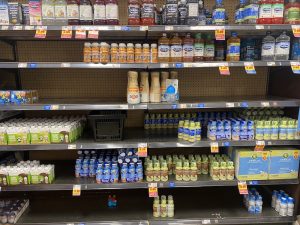The recently announced Bayer and Monsanto acquisition has grabbed headlines and raised fears. Farmers worry that the large market share in seeds and pesticides captured by the merger will increase prices of those goods, raising farm operating expenses. The announcement comes only two weeks after the August 30 release of 2016 agriculture projections by the USDA’s Economic Research Service. Here are four trends to investigate for stories on local agriculture.
Expenses are down, but revenue is down further
Projections for 2016 show that national farm revenue continues to decline and will likely hit the lowest levels since 2009. These declines are largely due to dropping commodity prices, 4 percent in crops and 10 percent in livestock. A host of issues are tied to these dropping prices, one being the debt to equity ratio on farms. This is a measure of the industry’s health, a higher ratio signifying that farms could have trouble staying afloat. Although debt is actually declining, commodity prices have triggered a larger drop in real estate value thus lowering farm equity. The ratio is projected to rise slightly in 2016.
The revenue decline has been partially offset by a projected decrease in farm expenses. The decrease is largely due to lower costs of feed and principal crop expenses including seed, pesticides and fertilizer. This is one reason the Bayer Monsanto acquisition is so worrisome to the agriculture industry. If the company were to raise expenses farmers could be hit doubly in the coming years.
Government funding is up
Government funding through the farm bill’s commodity price programs Price Loss Coverage (PLC) and Agriculture Risk Coverage (ARC) has risen from $5 million in 2015 to a projected $9 million for 2016. These programs provide a safety net for commodities when prices fall below certain levels. In 2016 the largest crop payments are predicted to be for wheat, corn, peanuts and soybeans. Government funding is another source of possible strain for the industry: Congress has only two weeks to approve a Continuing Resolution. Farmers who have already applied for grants or loans are waiting on the budget extension before they can get approval. If Congress passes the resolution, which is expected, it will specify the date Congress must pass a new farm bill, likely to be early next year. It is unclear how or if the newly elected government will change available programs.
Falling exports
The share of farm products that is exported has jumped significantly over the past two decades. However, this trend has started to reverse in the past few years and exports are estimated to be down 9 percent in 2016. The strong dollar combined with weak foreign economies has made trading more difficult. The raise in interest rates currently contemplated by the Federal Reserve could further damage agriculture exports by strengthening the dollar even more. Since exports currently make up about 30 percent of farm sales, a steep drop could have huge effects.
Certified organic production jump in 2015
Results of a 2015 survey of organic production were released September 15 and show a 13 percent rise in sales from 2014. Acres of land utilized for certified organic had a 20 percent increase over the same time. Organic farms are unevenly spread over the U.S. with California leading by far. Some organic commodities have also been splitting from the pack, with milk and eggs leading in sales. Certified organic egg sales were up 74 percent from 2014. Raspberries showed an even larger gain in sales of 230 percent. However, they still make up a relatively small portion of the market.
Reporter’s takeaway:
• National trends affect some areas more than others. You can find state and local data from the 2012 census that correspond with all the areas above. Think about why your state might be different from the national average. For instance, because some commodity markets have been harder hit, states that are high producers of these crops face a steeper drop in revenue. You can find up-to-date information on what your state produces under “quick stats.” This can help put national trends into a local context.
• Some types of farms have been able to avoid dropping revenues by innovating or creating a unique customer base. Small local farms may be able to keep prices steady by selling directly to consumers. See if anyone in your area has been able to maintain or even increase sales over the past year.
• The agriculture sector faces a lot of uncertainty in the coming months. Find out if farmers in your area are using USDA programs now and if they are worried about possible changes. You can do the same with the Monsanto Bayer merger, investigating if operating costs have been down in your area and what farmers think the effects of the acquisition will be. Trend numbers can provide background for these interviews.










